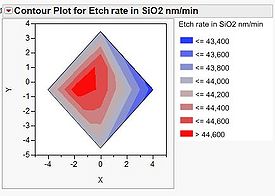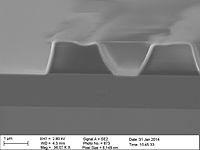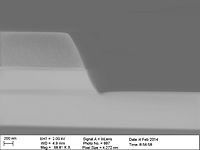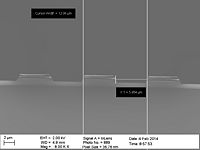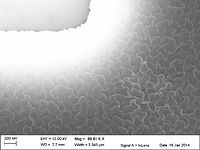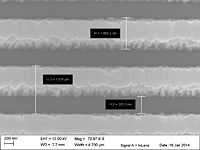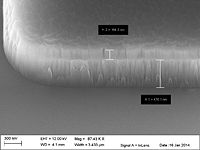Specific Process Knowledge/Etch/ICP Metal Etcher/silicon oxide: Difference between revisions
No edit summary |
|||
| Line 1: | Line 1: | ||
'''Feedback to this page''': '''[mailto:labadviser@nanolab.dtu.dk?Subject=Feed%20back%20from%20page%20http://labadviser.nanolab.dtu.dk/index.php/Specific_Process_Knowledge/Etch/ICP_Metal_Etcher/silicon_oxide click here]''' | '''Feedback to this page''': '''[mailto:labadviser@nanolab.dtu.dk?Subject=Feed%20back%20from%20page%20http://labadviser.nanolab.dtu.dk/index.php/Specific_Process_Knowledge/Etch/ICP_Metal_Etcher/silicon_oxide click here]''' | ||
{{CC-bghe1}} | |||
=SiO2 etching in the ICP metal= | =SiO2 etching in the ICP metal= | ||
It is possible to etch SiO2 in the ICP metal etcher but it is not designed for it and we prefer that you do it elsewhere. It is a challenge to get a good selectivity to resist (typically in the range of 1:1 or worse) and it is probably not possible to get a profile angle of 90 degrees. More likely about 75-85 degrees. Different chemistries can be applied either based on CF4 or C4F8. If seems that C4F8 can give the best selectivity to resist (best case I have seem was 1:11 but it depends a lot on the process parameters)). If low coil power is needed CF4 chemistry is used because C4F8 needs a higher power to generate a plasma. ''/bghe 2016-04-25 '' | It is possible to etch SiO2 in the ICP metal etcher but it is not designed for it and we prefer that you do it elsewhere. It is a challenge to get a good selectivity to resist (typically in the range of 1:1 or worse) and it is probably not possible to get a profile angle of 90 degrees. More likely about 75-85 degrees. Different chemistries can be applied either based on CF4 or C4F8. If seems that C4F8 can give the best selectivity to resist (best case I have seem was 1:11 but it depends a lot on the process parameters)). If low coil power is needed CF4 chemistry is used because C4F8 needs a higher power to generate a plasma. ''/bghe 2016-04-25 '' | ||
Revision as of 16:06, 6 February 2023
Feedback to this page: click here The content on this page, including all images and pictures, was created by Berit Herstrøm @ DTU Nanolab (BGHE), unless otherwise stated.
SiO2 etching in the ICP metal
It is possible to etch SiO2 in the ICP metal etcher but it is not designed for it and we prefer that you do it elsewhere. It is a challenge to get a good selectivity to resist (typically in the range of 1:1 or worse) and it is probably not possible to get a profile angle of 90 degrees. More likely about 75-85 degrees. Different chemistries can be applied either based on CF4 or C4F8. If seems that C4F8 can give the best selectivity to resist (best case I have seem was 1:11 but it depends a lot on the process parameters)). If low coil power is needed CF4 chemistry is used because C4F8 needs a higher power to generate a plasma. /bghe 2016-04-25
Slow etch of SiO2 with resist as masking material - using a 6" carrier wafer with recess
This recipe can be used for slow etching of SiO2 with resist as masking material. Here are some test results presented.
| Parameter | Resist mask |
|---|---|
| Coil Power [W] | 200 |
| Platen Power [W] | 25 |
| Platen temperature [oC] | 0 |
| CF4 flow [sccm] | 20 |
| H2 flow [sccm] | 10 |
| Pressure [mTorr] | 3 |
SiO2 etch using DUV mask
Two chemistry regimes has been explored: One using CF4 and one using C4F8
- CF4: bad selectivity to the resist mask.
- C4F8: Better selectivity to the resist mask can be achieved
- Tests done by Peixiong
- Tests done by Berit
- Test by Zhibo Li @nanolab dec. 2016 - based on the work of Peixiong and Berit: File:Zhibo Li SiO2 ICP etch (dose205).docx
| Parameter | Recipe on ICP metal: A SiO2 etch with C4F8 with resist mask |
|---|---|
| Coil Power [W] | 1000 |
| Platen Power [W] | 200 |
| Platen temperature [oC] | 0 |
| C4F8 flow [sccm] | 10 |
| H2 flow [sccm] | 28 |
| Pressure [mTorr] | 2.5 |
| Results | Test |
|---|---|
| Etch rate of thermal oxide |
|
| Selectivity to resist [:1] | 4-5:1 (SiO2:resist) by bghe@nanolab (2015-06-02) |
| Cr etch rate | 1.6 nm/min (1:90 to SiO2) by Martin Lind Ommen (fall 2016) |
| Profile [o] | 86-87 dg by bghe@nanolab (2015-06-02) |
| Wafer uniformity map (click on the image to view a larger image) | |
| SEM profile images |  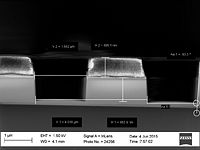 by bghe@nanolab (2015-06-02) |
| Etch rate in barc | |
| Etch rate in KRF resist | 34 nm/min by bghe@nanolab (2015-06-02) |
| Comments |
|
SiO2 etch nLOF
| Parameter | Resist mask |
|---|---|
| Coil Power [W] | 800 |
| Platen Power [W] | 100 |
| Platen temperature [oC] | 0 |
| CF4 flow [sccm] | 30 |
| H2 flow [sccm] | 10 |
| Pressure [mTorr] | 4 |
| Results | Test on wafer with 50% load (Travka 50), by BGHE @nanolab |
|---|---|
| Etch rate of thermal oxide | >110 nm/min (50% etch load) (09-03-2015) |
| Selectivity to resist [:1] | <0.7:1 (SiO2:resist) |
| Wafer uniformity (100mm) | Not known |
| Profile [o] | Not known |
| Wafer uniformity map (click on the image to view a larger image) | Not known |
| SEM profile images | NONE |
| Etch rate in nLOF resist | 1.6µm was removed after 10min |
| Comment | After 10min etch the resist was gone and the etch depth as 1.145µm in the oxide |
SiO2 etch with e-beam resist
| Process flow |
|---|
px1283lablejan1542014t1 250uc at 40mm x y pxline400p1000jan142014dt2 y= -40 -45 -50 -55mm dose 200 240 280 320uc
|
| Parameter | Resist mask |
|---|---|
| Coil Power [W] | 800 |
| Platen Power [W] | 150 |
| Platen temperature [oC] | -10 |
| C4F8 flow [sccm] | 8 |
| H2 flow [sccm] | 30 |
| Pressure [mTorr] | 2.5 |
| Results | Test on 6" wafer, by Peixiong Shi@nanolab |
|---|---|
| Etch rate of thermal oxide | 131 nm/min (15-01-2014) |
| Selectivity to resist [:1] | ~1.8:1 (SiO2:resist) |
| Profile [o] | Not measured |
| Wafer uniformity map (click on the image to view a larger image) | Not known |
| SEM images |
|

